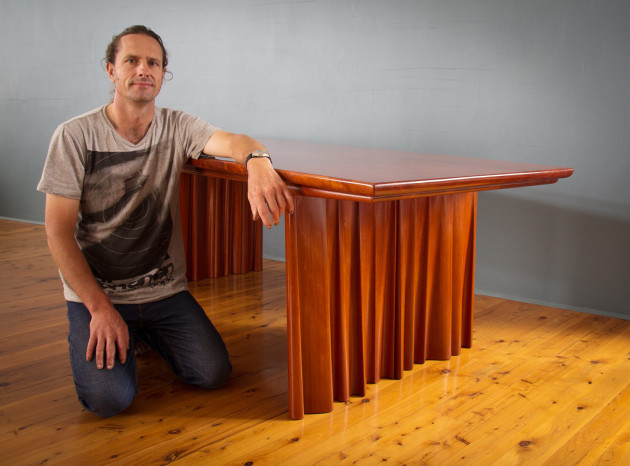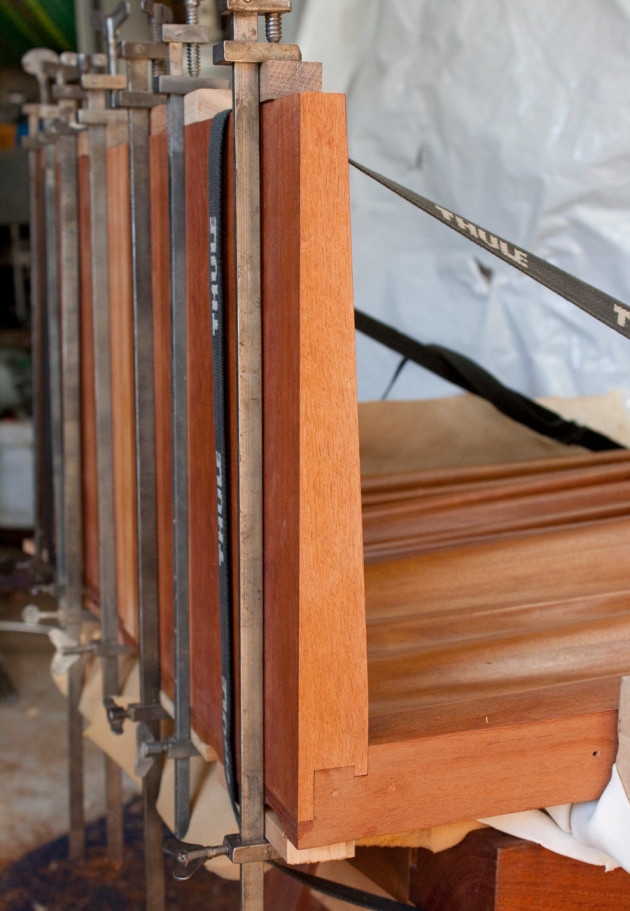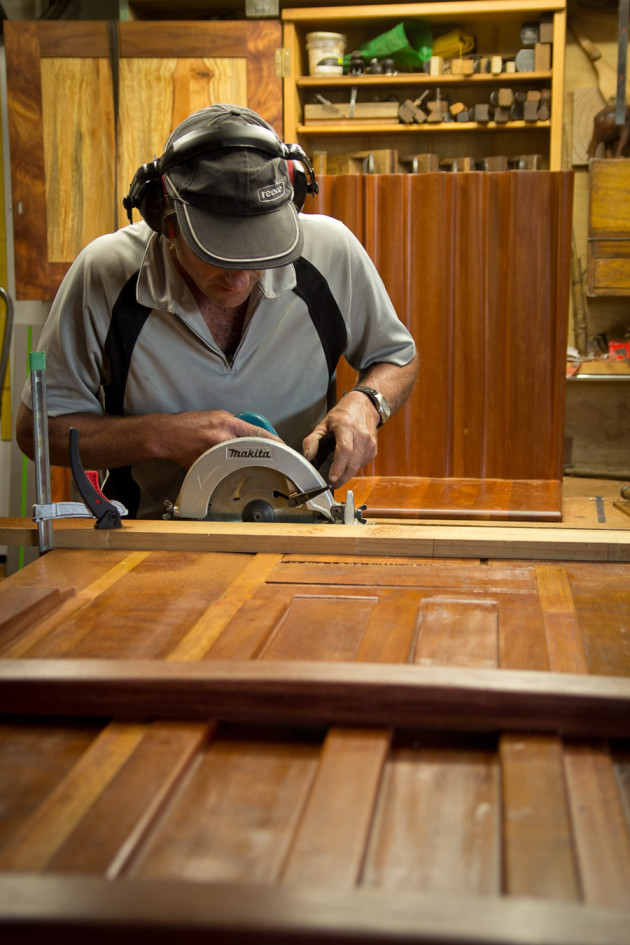Wave Table
Words: John Totenhofer
Photos: Jedda Lemmon
Diagram: Graham Sands
This table was a weekend project for me — in fact it took me a whole year of weekends to complete. I’m a builder by trade, but I like to make things in my free time as well. even if you don’t want to make a table like mine you could adapt the process of shaping the pedestal legs to other sculptural pieces.
I had purchased a few slabs of NSW rosewood (Dysoxylum fraserianum) from Boutique timbers over the course of a few wood shows. The challenge was how to build something that retained the width of the slabs. This design parameter led me to build a table with solid pedestal legs set back 380mm from the ends of the top.
In a design I like to try to have a detail, or leave a so-called defect as a reminder that the wood was once alive. this can be a real challenge for we all know how hard it is to incorporate a natural edge into a project and get it just right. For this table it was the size of the slabs and their reference to the trunk of the living tree which got me thinking.
Generally trunks are not that exciting, but I think buttress roots of fig trees, for example, are quite majestic and thought they would be a good starting point for the leg design. This led to the final profile which was more waves before they break. A breaking wave has a shallow back and a steep face, however I didn’t want the curves to be too consistent, as it is the changes in the shadowing that give form and definition.
Making the legs
The two pedestal ends consumed about three slabs that were about 2400 x 700 x 50mm. They were cut into sections that were 19 x 70mm or 19 x 50mm at one end tapering to 19 x 40mm at the other.
1. Glued up and trimmed blank for the legs with end profile marked.
This is the final blank after a number of separate glue ups, slowly building the blank to its final size. Using bamboo skewers as locating dowels, each lamination was offset one from the other to follow the curves on the plan. The dowels stopped them moving when gluing up. The laminations were arranged to give a consistency of colour. the finished leg was meant to look as if it had been carved from the one piece.
A simple U-shaped jig was made from MDF to hold the laminated and irregularly shaped blank, giving a flat surface to work off.
2. A U-shaped jig was used to hold the blank securely during machining and shaping.

You can see the jig above where I am cutting one end of the blank square. Both the top and bottom had to first be cut parallel and square. the jig was critical for routing the joint at the top of the leg and for holding the legs during the shaping process.
Now the fun could begin shaping the legs! I set to work with a good collection of curved planes that did most of the shaping, after some initial roughing out with a slick chisel.
3. A selection of handplanes and some chisels were used to hape the waves.

4. The waves varied to create more shadowlines.

The profile is not consistent from top to bottom. the curves at the top are shallower than the lower ones so I changed my plane profile to suit. I like this process as a challenge — the fact that it makes machinery impractical for the job keeps your hand skills up. I used some carving chisels, but only to a minor degree, and found the side rebate plane very handy on the outer curves. the legs are not identical as I wanted the table to be more of a sculptural piece.
5. Routing the top support and leg joint.
I made wing supports for the top that join to the pedestal legs. For stability these were made from 40 x 40 x 450mm glued up sections. The joint needed to be strong so I designed one that was cut with a few passes of the router.
The top and the pedestal legs were prefinished before gluing on the wing. this ensured the internal corner would look good. NSW rosewood is also prone to resin bleed if left too long unfinished. A few coats of hard shellac from Ubeaut polishes seems to stop this after first wiping the wood with metholated spirits on a rag.
6. Showing the glued up joint.
After gluing the two leg sections together, the exposed joint was covered with two mitred strips of rosewood. these were shaped to a suitable profile, then sanded and finished.
The top
Now, almost a year of weekends later, it was time for the top. I had some very figured slabs that must have been on the ground for many years before slabbing for they had become dusty and brittle but they were so beautiful. No one slab on its own was quite big enough for the top, so I split the big one lengthwise and glued a closely matched board between. This was not a bad thing because as we know single slabs are more prone to cupping.
7. I used my homemade router thicknesser to level the top sections.
So after levelling the sections for the top with my homemade router thicknesser , I routed a 12mm wide by 16mm deep grooves in the gluing edges to take tongues made from tallowwood. If you are on your own a tongue can be easier to handle when gluing boards that are a bit bowed. the tongues will also strengthen the joints.
8. Trimming the ends of the glued up top. The bracing and low profile side rails on the underside can be seen.
This photo shows me trimming the ends of the glued up top to length with my trusty power saw. You can see the jarrah cross braces that slot with allowance for movement into the low profile side rails (see the diagram below). A sharp jointer plane with a slight round to the blade levelled the top by planing at 90° to the grain. this was then followed up with cabinet scrapers and hand sanding.

When fixing tabletops to rails the rule is to allow for shrinkage. However the wood grain in the top and legs runs in the same direction so dominos for locating along with screws were used to securely attach the legs.
Hard shellac was also used to finish the top for the reasons above, even though in this application it will require more care and maintenance that other finishes. The construction and joinery of this table are not exactly traditional, but neither is its design, but then again most tables don’t take a year of weekends to build.
John Totenhofer is a builder based in the Illawarra, NSW. In his spare time he enjoys fine woodwork and being in the bush. He appeared on the cover of issue 80. This story is reprinted from issue 82, 2014.








